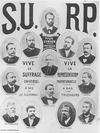(W)elke stem telt
Belgische (1899) en Nederlandse (1916-1917) opvattingen over democratie tijdens Kamerdebatten over evenredige vertegenwoordiging
DOI:
https://doi.org/10.51769/bmgn-lchr.13149Keywords:
political discourse, parliamentary culture, representation, comparative history, conceptual historyAbstract
Modifications to the electoral system in the Netherlands and Belgium at the turn of the twentieth century were the result of long discussions about what the ‘ideal’ parliamentary representation implied and how it had to be accomplished. Moreover, the mps’ additional reflection on the necessity of a proportional distribution of votes added an extra dimension to the debates in the Lower Houses. ‘Democracy’ then seemed to have become an unavoidable process. However, what did ‘democracy’ mean, exactly, for the parliamentary representatives of different political orientations in both countries? And what role was the introduction of the proportionality system expected to play in, for example, the limitation, display or promotion of said ‘democracy’? A detailed analysis of the parliamentary discourse with which the orators (in Belgium in 1899 and in the Netherlands in 1916-1917) made implicit and explicit connections between this new electoral system and their perceptions of democracy, reveals similarities and differences that surpassed the national boundaries and the left-right divide.
Downloads

Downloads
Published
Issue
Section
License
Copyright (c) 2023 Karen Lauwers

This work is licensed under a Creative Commons Attribution 4.0 International License.
Authors who publish with this journal agree to the following terms:
a) Authors retain copyright and grant the journal right of first publication with the work simultaneously licensed under a Creative Commons Attribution 4.0 International (CC BY 4.0) that allows others to share the work with an acknowledgement of the work's authorship and initial publication in this journal.
b) Authors are able to enter into separate, additional contractual arrangements for the non-exclusive distribution of the journal's published version of the work (e.g., post it to an institutional repository or publish it in a book), with an acknowledgement of its initial publication in this journal.
c) Authors are permitted to post their work online (e.g., in institutional repositories or on their website) prior to and during the submission process.
Authors are explicitly encouraged to deposit their published article in their institutional repository.







